What is records management?
Records management is a process companies use to manage documents that require extra care. Records carry more weight than regular documents and provide evidence for business decisions, transactions, and obligations. Once a document is deemed a record, no further edits or alterations are made.
An insurance claim is an example of a record. This record encompasses the claim form, statements, photographs, and other documents related to the claim. It’s common for organizations to choose document generation software to generate, customize, edit, and produce data-driven documents.
Types of records
There are different types of records, based on their purpose and how they are stored. Some records are digital, while others are physical. The five main record categories are listed below:
- Physical records: Copies of documents on paper that take up physical space
- Electronic records: Records created and stored digitally
- Enterprise records: Documents relating to a company’s operation, such as contracts, agreements, and payroll records
- Industry records: Records that pertain to the operation of a specific industry
- Legal hold records: Mandated records required by law, such as records about compliance regulations
Benefits of using records management
Proper records management helps organizations avoid penalties while growing their overall knowledge base. Ultimately, this informs future business planning decisions and creates more efficient practices for storing and retrieving records.
- Control what records are kept: As companies grow, they retain many electronic and physical records. Records management helps organizations control the number of records they create and maintain to avoid wasting storage space.
- Improve efficiency: Records management helps companies efficiently retrieve and dispose of records. This saves time, ultimately reducing the number of necessary billable hours.
- Stay compliant and minimize litigation risks: This process assists companies adhering to regulatory requirements. Keeping a safe and organized paper trail also reduces litigation risks.
- Informed business decisions: Easily accessible records help companies make management decisions faster and with more information. Records management builds up an organization’s knowledge base over time, which aids future planning.
Basic steps of records management
Records management is an involved process that ensures the proper handling and management of important documents. Basic steps of the records management process include:
- Declaration and registration: The record is placed in a repository and given a unique identifier to be easily tracked throughout the records management process.
- Access controls: Authorize certain users to access, retrieve, and read the record, but these users are not authorized to change the record or its metadata.
- Retention rules: Depending on the organization’s processes and relevant regulations, each type of record must be kept for a certain period of time. Retention time periods vary according to the record’s legal, fiscal, administrative, or historical value.
- Disposition: When records are no longer needed, they should either be destroyed or handed over to controlling legal authorities, like archives or libraries.
- Audit trails: This final step is creating an audit trail, which provides evidence for how records were managed from declaration to disposition.
Records management best practices
Records management systems vary from company to company. Depending on the industry, records management has to adhere to a specific set of regulations for compliance. In general, these best practices will always apply:
- Retention rules: Companies must know which records to keep and how long they should be kept to ensure legal and regulatory compliance.
- Indexing and categorization: Accurately indexing and categorizing records is crucial so that stakeholders know where to find the information they need.
- Secure storage: Whether records are stored digitally or physically, secure storage is vital to safeguard documents against damage and unauthorized access. For physical storage, a commercial records center that meets National Fire Protection Agency standards is recommended. Access controls, intrusion prevention, and barcode software should be used to secure digital records.
- Employee training: All employees in the organization should know how the records management system works. That way, records are always stored correctly through the appropriate processes. Written copies of the records management system rules should be distributed and ongoing training should be provided to ensure employees are up to speed.
Records management vs. document management
Records management and document management are organizational processes that add value to a company. These processes differ mainly due to the nature of what they are organizing.
Documents are information, structured or unstructured, that can be accessed by people within the organization. Records are documents that act as evidence of an organization’s functioning and policies, are often bound by compliance and cannot be altered.
Document management creates accountability for the document creation process. These systems are designed to make accessing, managing, collaborating on, and sharing documents easier. Document management enables easy access to documents, as well as version tracking and history showing all revisions that have been made.
Records management creates accountability for the management of records necessary for an organization to successfully conduct business. Records management focuses on identifying, storing, maintaining, and managing data pertaining to an organization’s statutory, regulatory, fiscal, or operational activities. Records management requires records to remain unchanged for legal purposes. Records management security is judged by the US Department of Defense 5015.2 regulations.

Martha Kendall Custard
Martha Kendall Custard is a former freelance writer for G2. She creates specialized, industry specific content for SaaS and software companies. When she isn't freelance writing for various organizations, she is working on her middle grade WIP or playing with her two kitties, Verbena and Baby Cat.



















